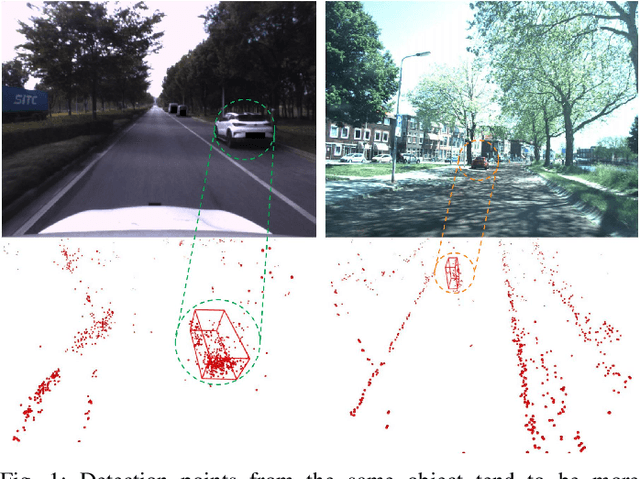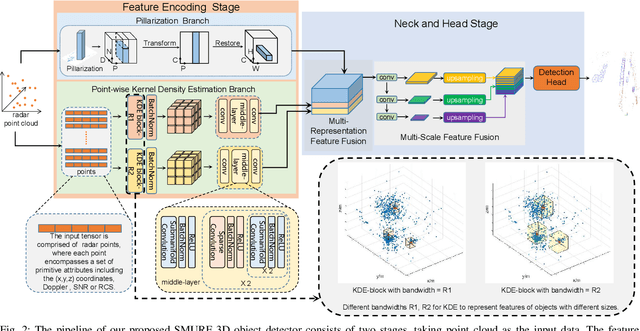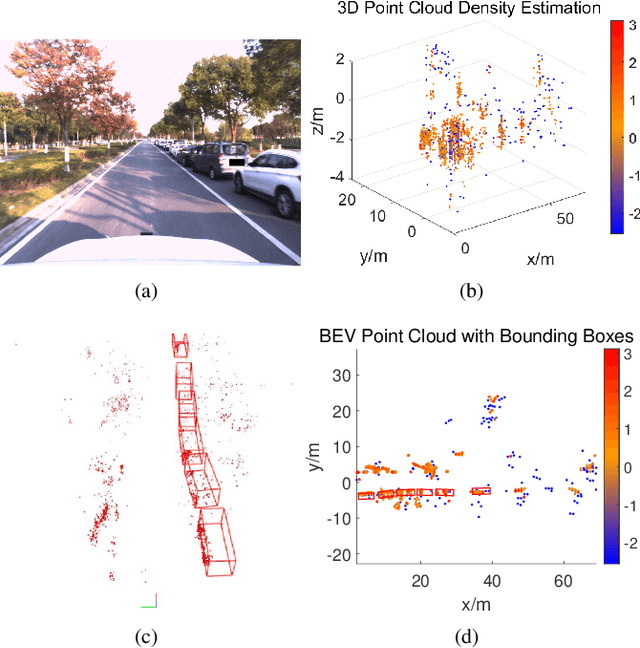Bing Zhu
RadarGaussianDet3D: An Efficient and Effective Gaussian-based 3D Detector with 4D Automotive Radars
Sep 19, 2025Abstract:4D automotive radars have gained increasing attention for autonomous driving due to their low cost, robustness, and inherent velocity measurement capability. However, existing 4D radar-based 3D detectors rely heavily on pillar encoders for BEV feature extraction, where each point contributes to only a single BEV grid, resulting in sparse feature maps and degraded representation quality. In addition, they also optimize bounding box attributes independently, leading to sub-optimal detection accuracy. Moreover, their inference speed, while sufficient for high-end GPUs, may fail to meet the real-time requirement on vehicle-mounted embedded devices. To overcome these limitations, an efficient and effective Gaussian-based 3D detector, namely RadarGaussianDet3D is introduced, leveraging Gaussian primitives and distributions as intermediate representations for radar points and bounding boxes. In RadarGaussianDet3D, a novel Point Gaussian Encoder (PGE) is designed to transform each point into a Gaussian primitive after feature aggregation and employs the 3D Gaussian Splatting (3DGS) technique for BEV rasterization, yielding denser feature maps. PGE exhibits exceptionally low latency, owing to the optimized algorithm for point feature aggregation and fast rendering of 3DGS. In addition, a new Box Gaussian Loss (BGL) is proposed, which converts bounding boxes into 3D Gaussian distributions and measures their distance to enable more comprehensive and consistent optimization. Extensive experiments on TJ4DRadSet and View-of-Delft demonstrate that RadarGaussianDet3D achieves state-of-the-art detection accuracy while delivering substantially faster inference, highlighting its potential for real-time deployment in autonomous driving.
LXLv2: Enhanced LiDAR Excluded Lean 3D Object Detection with Fusion of 4D Radar and Camera
Feb 20, 2025Abstract:As the previous state-of-the-art 4D radar-camera fusion-based 3D object detection method, LXL utilizes the predicted image depth distribution maps and radar 3D occupancy grids to assist the sampling-based image view transformation. However, the depth prediction lacks accuracy and consistency, and the concatenation-based fusion in LXL impedes the model robustness. In this work, we propose LXLv2, where modifications are made to overcome the limitations and improve the performance. Specifically, considering the position error in radar measurements, we devise a one-to-many depth supervision strategy via radar points, where the radar cross section (RCS) value is further exploited to adjust the supervision area for object-level depth consistency. Additionally, a channel and spatial attention-based fusion module named CSAFusion is introduced to improve feature adaptiveness. Experimental results on the View-of-Delft and TJ4DRadSet datasets show that the proposed LXLv2 can outperform LXL in detection accuracy, inference speed and robustness, demonstrating the effectiveness of the model.
Vision-Language Models Meet Meteorology: Developing Models for Extreme Weather Events Detection with Heatmaps
Jun 14, 2024



Abstract:Real-time detection and prediction of extreme weather protect human lives and infrastructure. Traditional methods rely on numerical threshold setting and manual interpretation of weather heatmaps with Geographic Information Systems (GIS), which can be slow and error-prone. Our research redefines Extreme Weather Events Detection (EWED) by framing it as a Visual Question Answering (VQA) problem, thereby introducing a more precise and automated solution. Leveraging Vision-Language Models (VLM) to simultaneously process visual and textual data, we offer an effective aid to enhance the analysis process of weather heatmaps. Our initial assessment of general-purpose VLMs (e.g., GPT-4-Vision) on EWED revealed poor performance, characterized by low accuracy and frequent hallucinations due to inadequate color differentiation and insufficient meteorological knowledge. To address these challenges, we introduce ClimateIQA, the first meteorological VQA dataset, which includes 8,760 wind gust heatmaps and 254,040 question-answer pairs covering four question types, both generated from the latest climate reanalysis data. We also propose Sparse Position and Outline Tracking (SPOT), an innovative technique that leverages OpenCV and K-Means clustering to capture and depict color contours in heatmaps, providing ClimateIQA with more accurate color spatial location information. Finally, we present Climate-Zoo, the first meteorological VLM collection, which adapts VLMs to meteorological applications using the ClimateIQA dataset. Experiment results demonstrate that models from Climate-Zoo substantially outperform state-of-the-art general VLMs, achieving an accuracy increase from 0% to over 90% in EWED verification. The datasets and models in this study are publicly available for future climate science research: https://github.com/AlexJJJChen/Climate-Zoo.
FinTextQA: A Dataset for Long-form Financial Question Answering
May 16, 2024



Abstract:Accurate evaluation of financial question answering (QA) systems necessitates a comprehensive dataset encompassing diverse question types and contexts. However, current financial QA datasets lack scope diversity and question complexity. This work introduces FinTextQA, a novel dataset for long-form question answering (LFQA) in finance. FinTextQA comprises 1,262 high-quality, source-attributed QA pairs extracted and selected from finance textbooks and government agency websites.Moreover, we developed a Retrieval-Augmented Generation (RAG)-based LFQA system, comprising an embedder, retriever, reranker, and generator. A multi-faceted evaluation approach, including human ranking, automatic metrics, and GPT-4 scoring, was employed to benchmark the performance of different LFQA system configurations under heightened noisy conditions. The results indicate that: (1) Among all compared generators, Baichuan2-7B competes closely with GPT-3.5-turbo in accuracy score; (2) The most effective system configuration on our dataset involved setting the embedder, retriever, reranker, and generator as Ada2, Automated Merged Retrieval, Bge-Reranker-Base, and Baichuan2-7B, respectively; (3) models are less susceptible to noise after the length of contexts reaching a specific threshold.
ProbRadarM3F: mmWave Radar based Human Skeletal Pose Estimation with Probability Map Guided Multi-Format Feature Fusion
May 08, 2024



Abstract:Millimetre wave (mmWave) radar is a non-intrusive privacy and relatively convenient and inexpensive device, which has been demonstrated to be applicable in place of RGB cameras in human indoor pose estimation tasks. However, mmWave radar relies on the collection of reflected signals from the target, and the radar signals containing information is difficult to be fully applied. This has been a long-standing hindrance to the improvement of pose estimation accuracy. To address this major challenge, this paper introduces a probability map guided multi-format feature fusion model, ProbRadarM3F. This is a novel radar feature extraction framework using a traditional FFT method in parallel with a probability map based positional encoding method. ProbRadarM3F fuses the traditional heatmap features and the positional features, then effectively achieves the estimation of 14 keypoints of the human body. Experimental evaluation on the HuPR dataset proves the effectiveness of the model proposed in this paper, outperforming other methods experimented on this dataset with an AP of 69.9 %. The emphasis of our study is focusing on the position information that is not exploited before in radar singal. This provides direction to investigate other potential non-redundant information from mmWave rader.
LiDAR Point Cloud-based Multiple Vehicle Tracking with Probabilistic Measurement-Region Association
Mar 12, 2024



Abstract:Multiple extended target tracking (ETT) has gained increasing attention due to the development of high-precision LiDAR and radar sensors in automotive applications. For LiDAR point cloud-based vehicle tracking, this paper presents a probabilistic measurement-region association (PMRA) ETT model, which can describe the complex measurement distribution by partitioning the target extent into different regions. The PMRA model overcomes the drawbacks of previous data-region association (DRA) models by eliminating the approximation error of constrained estimation and using continuous integrals to more reliably calculate the association probabilities. Furthermore, the PMRA model is integrated with the Poisson multi-Bernoulli mixture (PMBM) filter for tracking multiple vehicles. Simulation results illustrate the superior estimation accuracy of the proposed PMRA-PMBM filter in terms of both positions and extents of the vehicles comparing with PMBM filters using the gamma Gaussian inverse Wishart and DRA implementations.
Which Framework is Suitable for Online 3D Multi-Object Tracking for Autonomous Driving with Automotive 4D Imaging Radar?
Sep 13, 2023



Abstract:Online 3D multi-object tracking (MOT) has recently received significant research interests due to the expanding demand of 3D perception in advanced driver assistance systems (ADAS) and autonomous driving (AD). Among the existing 3D MOT frameworks for ADAS and AD, conventional point object tracking (POT) framework using the tracking-by-detection (TBD) strategy has been well studied and accepted for LiDAR and 4D imaging radar point clouds. In contrast, extended object tracking (EOT), another important framework which accepts the joint-detection-and-tracking (JDT) strategy, has rarely been explored for online 3D MOT applications. This paper provides the first systematical investigation of the EOT framework for online 3D MOT in real-world ADAS and AD scenarios. Specifically, the widely accepted TBD-POT framework, the recently investigated JDT-EOT framework, and our proposed TBD-EOT framework are compared via extensive evaluations on two open source 4D imaging radar datasets: View-of-Delft and TJ4DRadSet. Experiment results demonstrate that the conventional TBD-POT framework remains preferable for online 3D MOT with high tracking performance and low computational complexity, while the proposed TBD-EOT framework has the potential to outperform it in certain situations. However, the results also show that the JDT-EOT framework encounters multiple problems and performs inadequately in evaluation scenarios. After analyzing the causes of these phenomena based on various evaluation metrics and visualizations, we provide possible guidelines to improve the performance of these MOT frameworks on real-world data. These provide the first benchmark and important insights for the future development of 4D imaging radar-based online 3D MOT.
SMURF: Spatial Multi-Representation Fusion for 3D Object Detection with 4D Imaging Radar
Aug 02, 2023



Abstract:The 4D Millimeter wave (mmWave) radar is a promising technology for vehicle sensing due to its cost-effectiveness and operability in adverse weather conditions. However, the adoption of this technology has been hindered by sparsity and noise issues in radar point cloud data. This paper introduces spatial multi-representation fusion (SMURF), a novel approach to 3D object detection using a single 4D imaging radar. SMURF leverages multiple representations of radar detection points, including pillarization and density features of a multi-dimensional Gaussian mixture distribution through kernel density estimation (KDE). KDE effectively mitigates measurement inaccuracy caused by limited angular resolution and multi-path propagation of radar signals. Additionally, KDE helps alleviate point cloud sparsity by capturing density features. Experimental evaluations on View-of-Delft (VoD) and TJ4DRadSet datasets demonstrate the effectiveness and generalization ability of SMURF, outperforming recently proposed 4D imaging radar-based single-representation models. Moreover, while using 4D imaging radar only, SMURF still achieves comparable performance to the state-of-the-art 4D imaging radar and camera fusion-based method, with an increase of 1.22% in the mean average precision on bird's-eye view of TJ4DRadSet dataset and 1.32% in the 3D mean average precision on the entire annotated area of VoD dataset. Our proposed method demonstrates impressive inference time and addresses the challenges of real-time detection, with the inference time no more than 0.05 seconds for most scans on both datasets. This research highlights the benefits of 4D mmWave radar and is a strong benchmark for subsequent works regarding 3D object detection with 4D imaging radar.
LXL: LiDAR Excluded Lean 3D Object Detection with 4D Imaging Radar and Camera Fusion
Jul 07, 2023



Abstract:As an emerging technology and a relatively affordable device, the 4D imaging radar has already been confirmed effective in performing 3D object detection in autonomous driving. Nevertheless, the sparsity and noisiness of 4D radar point clouds hinder further performance improvement, and in-depth studies about its fusion with other modalities are lacking. On the other hand, most of the camera-based perception methods transform the extracted image perspective view features into the bird's-eye view geometrically via "depth-based splatting" proposed in Lift-Splat-Shoot (LSS), and some researchers exploit other modals such as LiDARs or ordinary automotive radars for enhancement. Recently, a few works have applied the "sampling" strategy for image view transformation, showing that it outperforms "splatting" even without image depth prediction. However, the potential of "sampling" is not fully unleashed. In this paper, we investigate the "sampling" view transformation strategy on the camera and 4D imaging radar fusion-based 3D object detection. In the proposed model, LXL, predicted image depth distribution maps and radar 3D occupancy grids are utilized to aid image view transformation, called "radar occupancy-assisted depth-based sampling". Experiments on VoD and TJ4DRadSet datasets show that the proposed method outperforms existing 3D object detection methods by a significant margin without bells and whistles. Ablation studies demonstrate that our method performs the best among different enhancement settings.
RaLiBEV: Radar and LiDAR BEV Fusion Learning for Anchor Box Free Object Detection System
Nov 11, 2022Abstract:Radar, the only sensor that could provide reliable perception capability in all weather conditions at an affordable cost, has been widely accepted as a key supplement to camera and LiDAR in modern advanced driver assistance systems (ADAS) and autonomous driving systems. Recent state-of-the-art works reveal that fusion of radar and LiDAR can lead to robust detection in adverse weather, such as fog. However, these methods still suffer from low accuracy of bounding box estimations. This paper proposes a bird's-eye view (BEV) fusion learning for an anchor box-free object detection system, which uses the feature derived from the radar range-azimuth heatmap and the LiDAR point cloud to estimate the possible objects. Different label assignment strategies have been designed to facilitate the consistency between the classification of foreground or background anchor points and the corresponding bounding box regressions. Furthermore, the performance of the proposed object detector can be further enhanced by employing a novel interactive transformer module. We demonstrated the superior performance of the proposed methods in this paper using the recently published Oxford Radar RobotCar (ORR) dataset. We showed that the accuracy of our system significantly outperforms the other state-of-the-art methods by a large margin.
 Add to Chrome
Add to Chrome Add to Firefox
Add to Firefox Add to Edge
Add to Edge